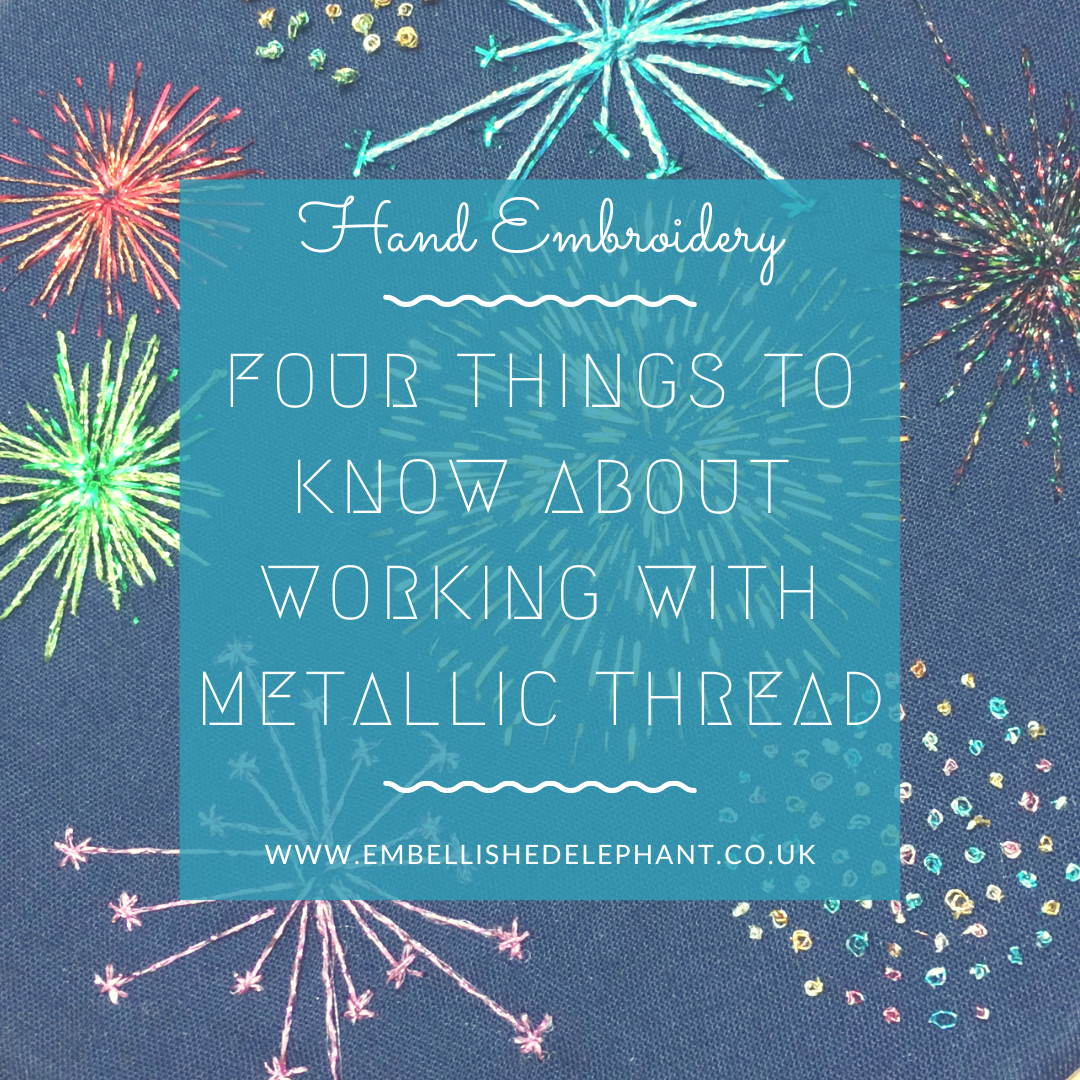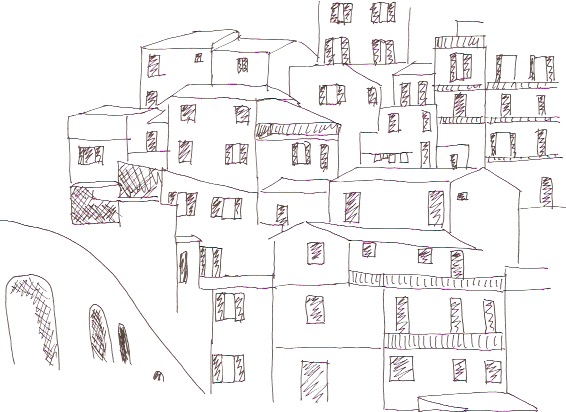It’s been 18 years since I last visited New York. There is so much to see and do there, here are a few images from my recent trip that have been a source of creative inspiration since I returned.
Four things to know about working with metallic thread
New Years Eve 2018 I was lucky enough to view the fireworks from the 10th floor balcony of a building that overlooks the Thames.
When my parents moved house my Mum de-stashed (not by very much her home studio is still full!) I inherited some lovely metallic threads in a range of colours. To play around with these threads I stitched this firework embroidery sampler.
Some things I learned from stitching with metallic threads:
they tangle
they split
they wear at the point where they pass through the eye of the needle
they are much rougher than normal embroidery floss
The top tip for working with metallic threads is to keep the lengths of threads you use much shorter than you would normally stitch with - this will help immensely with the tangling, splitting and wearing.
These threads are rougher than normal floss, normally as the metallic part is wrapped around a thinner inner thread. it can make some stitches such as French knots more challenging. It doesn’t mean you can’t stitch these, but I’d recommend so practice and patience! The rougher thread also means that trying to undo a tangle is particularly horrendous
Enjoyed this blog post? I share embroidery tips and a free embroidery pattern in my monthly newsletter. Sign up here to receive the newsletter on the 1st of each the month.
Basics of hand embroidery
The first module of my City & Guilds course was all about the basics - trying different stitches. To complete this module we had to complete 4 samples - line stitches, textural stitches, isolated stitches and blocks of stitches.
The latter was the most enjoyable - I researched as many different stitches as I could (this book has a surprisingly wide range). I divided up my fabric into rectangles using a water soluble pen and started stitching. This was the sample in progress at my local cafe.
Brussels and Bruges inspiration
I love a trip on the Eurostar (who doesn’t!) and wanting a bit of inspiration I was flicking through some photos and found these. Despite the grey and cold on this particular trip, the shapes and colours of the buildings are great inspiration.
Designs on a theme
Module 2 of my City & Guilds course was a pure design module, not a stitch in sight. A lot of the work I’ve done in the past has either been intuitive or I have a very clear idea in my head and I experiment until I achieve the desired effect. Therefore sitting down and designing something from scratch for no purpose other than to create a design was alien to me.
However, we were guided through the process starting with selecting a theme and four photos on that theme. The theme I chose was ‘blocks’.
Clockwise from top left: Cinque Terre near Genoa, wall of Suomenlinna fort near Helsinki, Temple ruin near Angkor Wat, exhibit in Pergammon Museum in Berlin
We then traced elements of those photos and repeated those elements to further the designs. I started off using pen and paper but I found a great app on my iPad that allowed me to trace the photo electronically which gave a much more polished and professional look.
Below are some of the favourite of the designs I created for this module.
Cambodia inspiration
I’d wanted to visit Cambodia for a long time and in summer 2018 it actually happened. South East Asia is so different to the UK so I find it hard not to be inspired by the sights, food and plants.
Recently I wanted to experiment with printing photos onto fabric to embroidery over and I knew immediately the image I wanted to pick.
The image below I used as inspiration in module 2 of my City & Guilds course - this was a design module and we had to pick a theme. The theme I finally settled on was ‘blocks’.
The other images below are different textures from my trip which are sure to be sources of inspiration for future projects.
Distance learning City & Guilds course
I’ve always been a self taught crafter supplemented by the odd workshop or short course. I’ve never had any formal education in art or craft. After all these years I felt it was about time to get some more formal education, and as I’m currently obsessed with embroidery this was the course I wanted to do.
Most of the options I could find were year-long daytime courses which just didn’t suit my needs (as I work full time). So I googled and came across School of Stitched Textiles.
I wasn’t sure about it at first as I couldn’t find any reviews or feedback and didn’t want to pay out the course fee without some idea of what I might be getting. But I went for it in the end and I’m glad I did.
So I want to share my experience a few months after signing up:
There are only a limited number of places available each registration period (and only a limited number of registration periods a year) so if you find a course you want to do you can’t necessarily start straight away.
You can chose a level and discipline, the brochures on the site give you descriptions of what is covered in each level. I felt I was already skilled in everything in level 2 but level 3 covered an number of styles I’d not tried (as well as some I had) and this seems the right level for me.
The courses aren’t cheap, but the level 3 course I’m on is meant to take 2 years so works out at a monthly cost of about £80. You can pay in one lump sum or instalments. I was worried I wouldn’t like the course or life would get in the way but the additional cost of the instalments led to my decision to pay a lump sum. I was lucky to have the savings to pay for it in one go so could make that decision.
Once you’ve signed up and paid you get added to a Facebook group with the other students in your cohort. There are live tutor chats, the timing has so far not worked out for me to join live but you can watch the recording. You are encouraged to share pictures of your progress in the group.
About 3 weeks after you sign up you get the materials for the first 3 modules sent through as well as the course specification and an intro module. I made sure I read each module in detail and then started breaking down the module into actionable chunks as sometimes exactly what is needed takes some unpicking. I then used Trello to plan the tasks and the time needed for each (I love a project plan!) It also helps to plan ahead to order the necessary materials.
Modules 1-3 require you to research other artists. For each one I thought I knew which artist I wanted to use but ended up researching 2 or 3 before finding the right one for that task. It is worth getting this bit right.
Modules 1 & 3 involve stitching, module 2 doesn’t. I had a bit of an itch to stitch mid way through module 2 so started work on module 3. You should do the modules and tasks in order as the build in each other but I was mostly complete module 2 when I started on module 3.
The amount of time you spend on your samples depends on how much stitching your design involves. Many of my designs so far have involved dense blocks of stitching so have taken quite a long time to complete.
A distance learning course suits me - being mostly self taught I’m comfortable relying on my own research (although you are assigned a tutor alongside the Facebook group) but this style of learning may not suit everyone.
Kew Gardens Inspiration
Botanicals art is a huge trend at the moment, whether it is prints, embroidery, paper cutting or any other creative medium, you will find botanicals. The perennial (!) favourites are cacti and monstera (cheese plant), but there are so many other plants that give dramatic foliage or forms perfect to inspire your work.
I studied biology at university and my first ever visit to Kew Gardens was when we were dispatched to look at how plants of different climate have adapted to their environments.
This time I just wanted to admire the beautiful plants and take some photos to inspire my creative work.











































